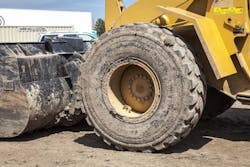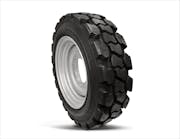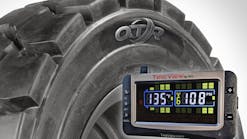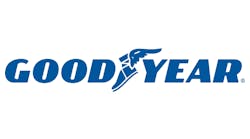Poor or sporadic maintenance of on-road and off-road tires can affect equipment availability and operating costs, so incorporate tire management into a preventive maintenance (PM) program, and work to get buy-in from your drivers and your operations department.
Tires can be easily overlooked, especially if they appear properly inflated, but there’s no substitute for regular checks. One way to ensure they occur is mandating their inclusion in regular maintenance.
“Our tire-management program is 100-percent incorporated into our PM program,” says two-time AEMP and Construction Equipment Fleet Master Michael Brennan, CEM, fleet manager for Manatee County, Fla. “All of our PM sheets have a section for tire tread depth and air pressure. We’re going to record the tread depth and what the air pressure is when it comes in, and if the air pressure is low or out of parameter, we will make sure that all the tires are properly inflated.”
Then there are the less obvious items.
“Also included in that PM service, we inspect them for cuts, and we know the wear they’re going to get between now and the next PM,” Brennan says. “If those tires will not safely make the next PM, they need to be changed before the vehicle leaves. We will not run them down to less than 2/32’s; it’s more cost-effective to change them rather than take the vehicle back out of service later to change the tires—you’re creating more downtime.”
Preventive maintenance periods vary, of course, depending on the type of vehicle or equipment, but there is an ideal, according to tire manufacturer Bridgestone.
The ideal: air and more
“The ideal program would be once a week,” says Greg McDonald, engineering manager, corporate accounts, for Bridgestone, “and that the tires are inspected above and beyond the driver, who is supposed to be doing it every day. They should be inspected for air pressure, irregular wear, wear out, and damage.”
McDonald stresses that air pressure should be checked while the tires are cold, as a vehicle that’s just finished operating has increased pressure. “The vehicle should be stationary for at least three hours in order to get a correct inflation pressure reading,” he says.
“If the vehicle cannot be stationary for three hours, about all you’re accomplishing with checking inflation pressure is finding a tire that’s obviously different from the others, which would indicate a problem. But cold inflation pressure being set correctly for the tire size and the load it’s having to carry is critical to the performance and the longevity of the tire,” McDonald continues. “A general rule on inflation is that for every 10 percent of inflation that you’re running below recommended required, you’re going to lose about 10 percent on your tire life.”
Not every fleet sees its trucks once a week to check air pressure, and not every operator checks the tires as part of a daily inspection, so spotting irregularities during a PM session is even more important.
“We actually probe the tires on PM, so we make sure we pull out all the rocks, any pieces of glass, nails, or anything else that may be in the tire,” Brennan says. “When you have a flat, it’s often because of a screw or a nail or something that generally has been in that tire quite awhile, and it’s finally worked its way through the rubber and the casing, and now you’ve got a leak. We’ll pull out even very small screws and nails before they puncture the tire.”
There are cost consequences for not checking.
“You will have a greater chance of downtime on the road, and that’s a major cost,” McDonald says. “An on-road service call is a lot of expense. And, you stand to have a greater incidence of tires that are removed prematurely for damages that could have been easily repaired if caught early, but if let go, result in tire failure and/or loss of a casing. Consequently, your casing bank is going to be impacted by the number of casings that are viable for retreading.”
Retreads and mating
Retreading (also called recapping or capping) is another strategy to consider, if you haven’t already. Brennan has studied the strategy and has had the optimum rolling lab for experimentation: Manatee County has off-road heavy equipment, on-road pickups, vans, buses, and ambulances.
“In our transit bus fleet, we’ll buy new buses that will come in with new tires on them, and the first thing we’ll do is peel all the new tires off the rear axle and put recaps on,” he says. “Because I can recap a tire for a little over $100 and that new tire is going to cost me about $350. So I’ll save all those new tires for steer axle tires, and I’ll run the recaps on the rear—I’ve already saved a significant amount of money.”
Brennan is quick to point out that not every fleet can switch out. “You’ve got to be able to generate the casings to be able to do that, and if you’re running a large fleet with a lot of similar-type vehicles, you’ve got to make sure that when you’re specing your vehicles, you spec the same tires and generate your own recaps.”
Recap programs do have their limits.
“We only cap a tire one time,” Brennan says. “We find that after you’ve run a new tire down and you’ve capped it, and then you run that down, you’ve probably got some issues with the casing or you’ve had a couple of punctures where you’ve had to patch the tire for a repair.
“We’ve found that our failure rate for the second, or beyond, cap is far greater than on the first cap. So, now I only cap them the one time, then I sell my casings.” Brennan sells the casings to a tire service center that he already contracts with for repairs; it’s built into the agreement.
Brennan also has advice on matching tires, borne from extensive studies the county did comparing tires, retreads versus new tires, mileage, and wear.
“If you’re running dual axles on your trucks, you have to match the tires,” Brennan says. “We’ve had a matching program for a long time, and we have the tools in the shop that the technicians can use to make sure the tires are matched.
“If we have a flat where we actually have to pull a tire off of a truck, or anything that has dual tires on it and one wheel position, and we find one tire has any more than 4/32 [of an inch tread-depth] difference, we have to replace both tires. And we’ll put the good tire we keep in a ‘used tire’ position, or we’ll store it as a used tire. Then when we need it, we will bring it out and reinstall it on a vehicle it will mate up to,” he says.
Drilling down on tire costs
Gauging the specific impact of tires’ effects on operating costs can be tricky. There are no hard-and-fast rules similar to a crawler dozer, for example, where you know up front that the undercarriage will account for close to 50 percent of your maintenance costs. Rather, it depends on the specific type of vehicle, the tire size, and the application.
“A fleet should do their research and acquire that number themselves,” Bridgestone’s McDonald says. “If they can do it individually by truck, they might be able to find an anomaly where they can address whether they have a driver problem, a truck problem, or a route problem.”
Brennan agrees that the search for data needs to stay specific within a class or type of vehicle. He cites wheel loaders as an example. Manatee County runs wheel loaders in its parks department using a turf-type lug pattern; loaders in stockpile and load-and-fill operations using standard, heavy lug-type loader tires; and loaders in its landfill equipped with R5 mining tires. Different tires and different applications, all with the same-sized wheel loader.
“So when you talk about assigning a percentage of operating costs to tires, you’ve got to look specifically at the type of vehicle and the task it’s performing,” he says.
Get everyone on board
“Another challenge is keeping the maintenance effort steady and continuous throughout your organization, depending on the size of the organization,” Brennan says. “If you’re a small operation, it’s much easier to control it. If you’re a very large regional or national organization, it’s a real challenge to have an effective tire-management program and it takes a lot of time and attention.”
Brennan recommends getting operator-level buy-in on checking air pressures. “When you’re running off-road trucks, or even on-road trucks, drivers are supposed to do a daily inspection of that vehicle because they’re holding a CDL license,” Brennan says. “You have to have those operators buy in so that they’re going to assist you in between the PMs to maintain those tires and that air pressure, but that’s one of the hardest things to do.
“It’s very hard for a fleet manager to control that, because the drivers are usually controlled by Operations and not Fleet. We keep open communication with them. We have to make sure they understand that if you have a tire failure on this machine or this truck due to under inflation and we know when it went out that it was under inflated, or we see there’s a big bolt in it and it has been there awhile, that their machine or truck is going to be down,” he says.
“There’s a loss of productivity in this situation, they’re not going to get their job done on time, and there’s a cost associated with the premature failure—and we’re going to bill them back for that cost.”
A large part of getting that institutional buy-in is convincing drivers, operators, and the operations department that it is in their best interests to check tires, just like it is to daily maintenance checks and lubrication of equipment.
“If you have a tire-management program built into your PM program and you maintain that, and make sure your staff knows about it, you’re going to be minimizing your cost per mile on your tire program,” Brennan says. “If you keep your tires properly inflated, you’re going to get the best mileage, the best handling, and have a safe vehicle on the road.”





